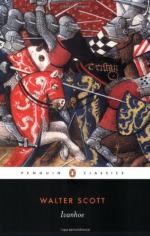|
This section contains 7,758 words (approx. 26 pages at 300 words per page) |

|
SOURCE: "The Historical Picturesque and the Survivals of Chivalry," in Scott's Novels: The Plotting of Historic Survival, University Press of Virginia, 1966, pp. 150-245.
In the following excerpt, Hart claims that Scott combines chivalric and anti-chivalric attitudes in Ivanhoe, as seen in his attempt to mitigate the self-centered pursuit of glory with moral prudence, and that Ivanhoe does not represent Scott's departure from historical fiction.
The distance from The Heart of Midlothian (1818) to Ivanhoe (1819) seems huge. It is smaller, however, than critical orthodoxy recognizes. Ivanhoe's inferiority is not to be explained in the simple categories customarily imposed: Scots versus non-Scots, recent versus remote, "reality" versus "tushery" and "pasteboard." That most of the early novels came from "living memory" and most of the later ones from "bookwork" has been claimed, and the exaggeration implies a naive misrepresentation of the creative process. Even were it not exaggerated, the claim would be...
|
This section contains 7,758 words (approx. 26 pages at 300 words per page) |

|


